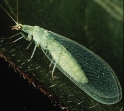This post may contain affiliate links. That means if you click and buy, I may receive a small commission. Please read my full disclosure policy for details.
The best and healthiest way to control pests in your garden is to practice organic garden pest control. We show you how to use biological controls here.

Organic garden pest control…through natural means
By far
the best (and greenest) way to control pests in a hydroponic garden is
through the use of biological controls (beneficial predators). This is a
tried-and-true greenhouse method that can also be used on a screened-in
porch or closed-off room inside your house. However, for obvious
reasons, you wouldn’t want to release 1500 live ladybugs in your living
room!
TIP
Once the predators clean your system of the bad bugs, they generally
disappear from your garden. Nothing left for them to eat, so they either die off or go
in search of greener pastures!
Now don’t dismiss this wonderful system as too complicated
or costly. It’s really very simple once you match the proper predator to
your particular pest invasion. Mail order insects are readily available
from most any garden or hydro supply site. And you will be treating
your infestation without chemicals, using Mother Nature’s own arsenal of
“good bugs”.
All of these beneficial insects are perfectly
harmless to you, pets or your plants. They just eat the harmful bugs,
and their larvae. Tons of ’em.
WHAT IS IPM?
Getting interested in organic garden pest control?
Good, let’s learn more about IPM (integrated pest management) using beneficial insects.
So
you have discovered some bugs on your hydroponic plants… yuck! Now
what? You might want to explore the use of predatory insects to rid your
garden of pests, before resorting to more drastic (and unhealthy)
measures.
IPM is especially helpful in cases where you have a big
infestation, as these “good critters” can devour literally hundreds of
“bad pests”. However, you will need to have them up and hatched before
your garden is overwhelmed.
First, you need to identify which bugs you have. To do this, see our page “Identifying garden pests”.
You will likely find your culprit in the “Top 6 Pests” section. Now
just order the correct predator for that particular insect from the list
below.
 |
 |
 |
 |
|
Predatory Wasp |
Ladybug |
Predatory Mite |
Lacewing |
Sure do appreciate if you could use our Amazon affiliate links below to order your critters:
WHITEFLY– Use Whitefly Parasites, (encarsia formosa). Don’t be alarmed, these tiny wasps do not sting! They just eat whiteflies.
MEALYBUGS– Order Lady Bugs, usually come in containers of 150 live bugs. They can even be kept in the refrigerator until needed (but not the freezer).
APHIDS- Are controlled by ladybugs (see above), Green Lacewings or gall midges. Lacewings make a good all-around predator, as they attack aphids, mealybugs, whitefly, and thrips.
THRIPS- Green Lacewings take care of these.
SPIDER MITES- Order Predatory Mites (phytoseiulus persimilis).

Reply